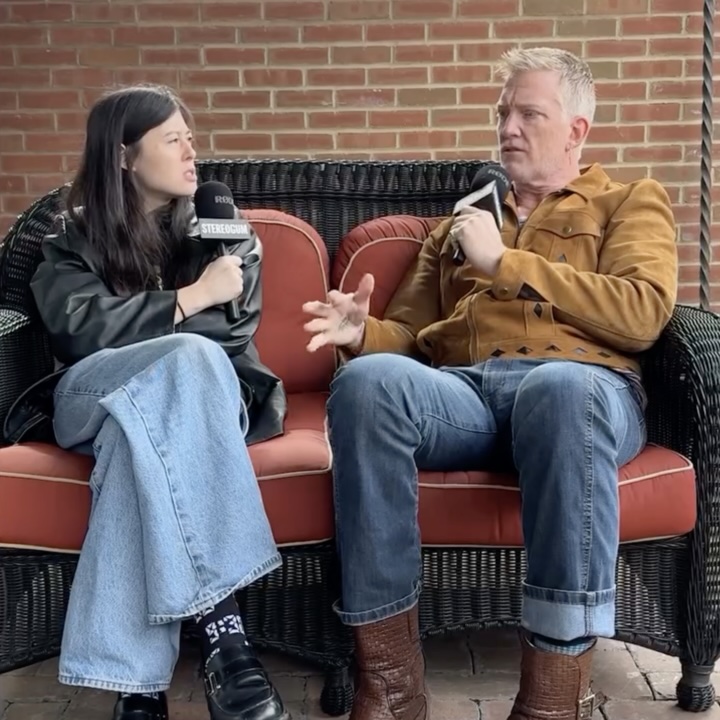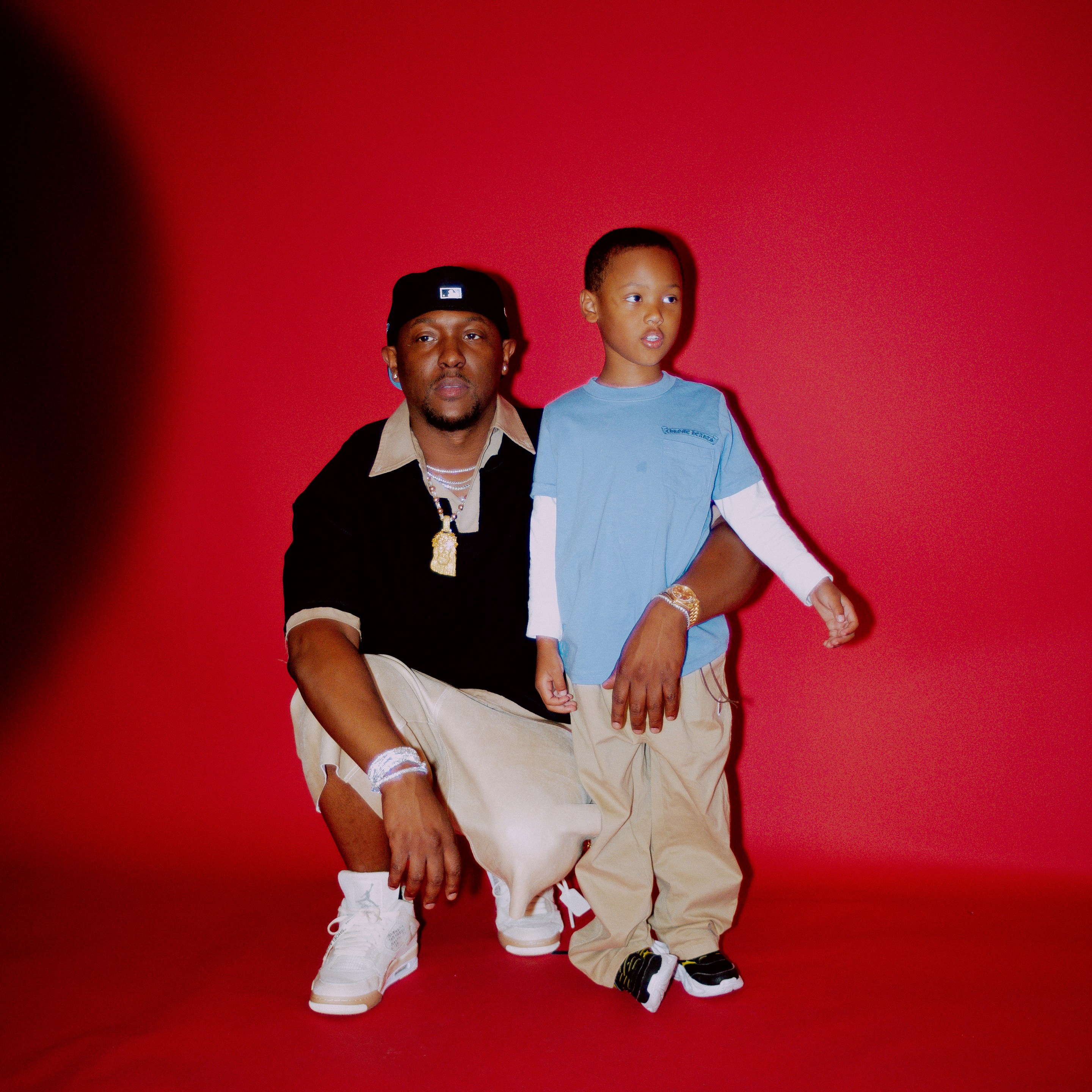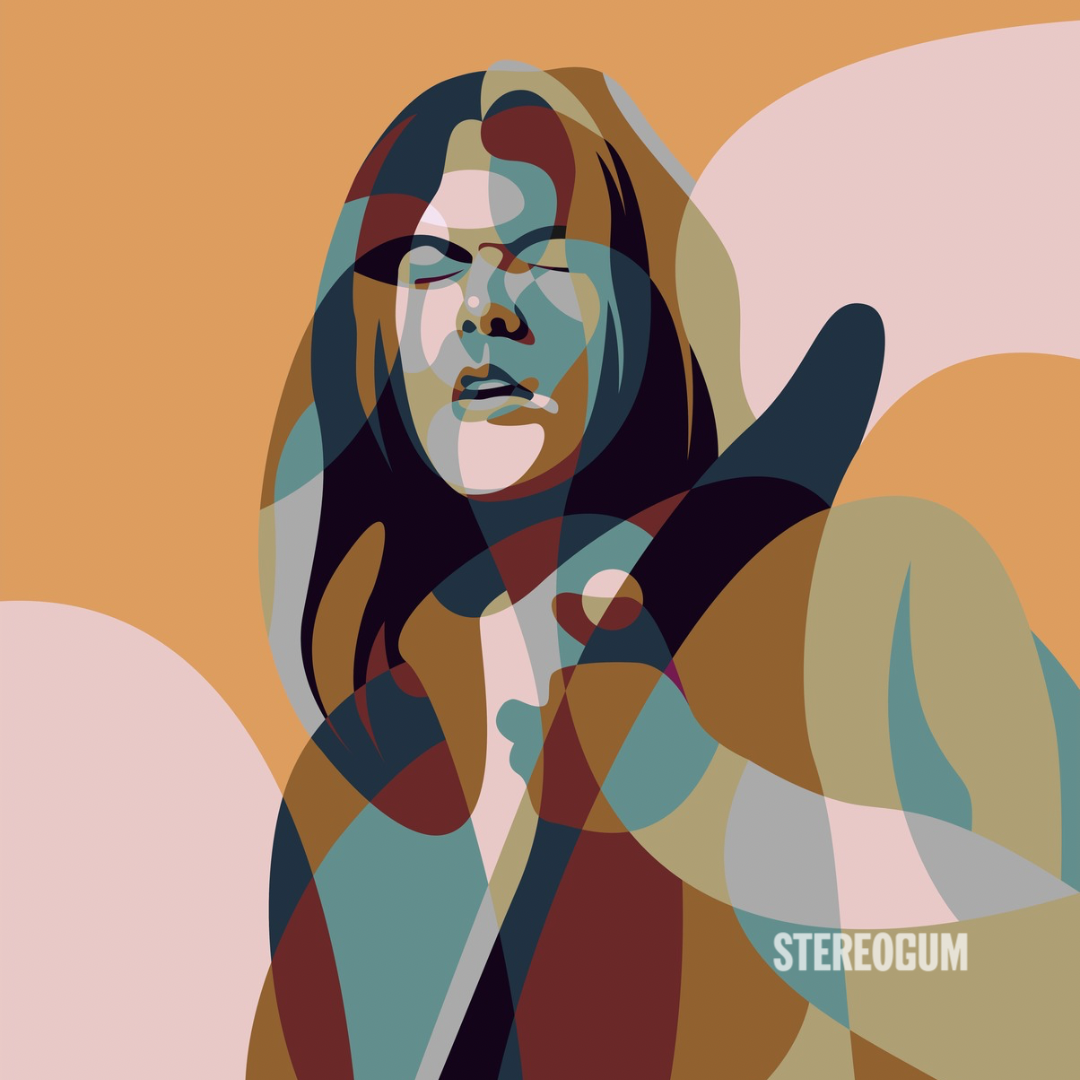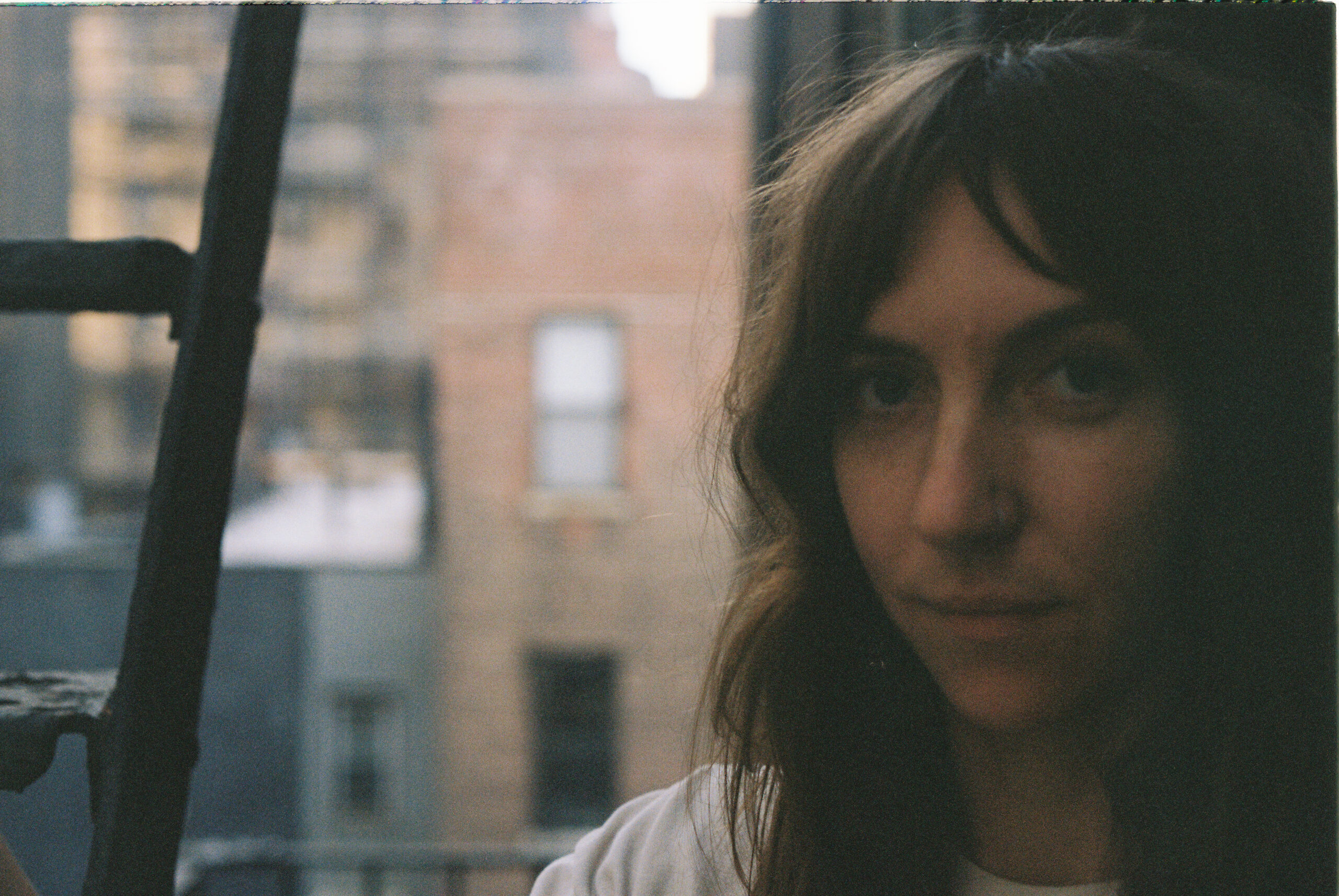We've Got A File On You features interviews in which artists share the stories behind the extracurricular activities that dot their careers: acting gigs, guest appearances, random internet ephemera, etc.
Even as he enters the fifth decade of a run that's earned him a reputation as rap's foremost radical, it's no surprise that Chuck D still refuses to rest on his laurels.
Throughout a year that's celebrated as hip-hop's 50th birthday, Public Enemy's influential frontman — whose booming baritone galvanized generations to action akin to a frontline general leading his troops to battle — has kept himself busy with a slew of projects dedicated to saluting the culture & genre's golden jubilee.
In 2023 alone, he rounded up dozens of rap deities from KRS-One to Killer Mike as important talking heads on his acclaimed PBS/BBC four-part docuseries Fight The Power: How Hip-Hop Changed The World, co-produced the five-episode Audible podcast Can You Dig It? about hip-hop's genesis in the Bronx, partnered up with Major League Baseball as a music ambassador, revisited his love of art and comics by releasing a series of "naphic grovels" that tackle gun violence and the chaos of the pandemic years, and launched Bring The Noise — a "culture media" app named after one of Public Enemy's defiant sermons.
Despite taking part in numerous ventures that would overwhelm the average artist, the 63-year old sticks to a self-prescribed tenet that doesn't allow him to experience any creative burnout whatsoever. "I try to keep it as 'five fingers on a hand,'" says the protest rap trailblazer born Carlton Ridenhour, who picks off each finger from his open palm to demonstrate his doctrine over our video call. "There's the music. Then the art. Then there's Rapstation and rap curation, and through being a talking head on documentaries like Fight The Power, there's the areas of film and TV production. I try not to go more than five because you could be everywhere and nowhere at the same time."
Given the disarray we're constantly seeing on the news right now, it's fitting that this month will see Def Jam dropping a special 35th anniversary vinyl edition of Public Enemy's classic call-to-arms It Takes a Nation of Millions To Hold Us Back — an emphatic anti-establishment manifesto that still resonates to this very day. Ahead of its release, Chuck reflects on a range of moments that have dotted the lines of a legendary career — including the significance of Spectrum City, Public Enemy's seminal 1987 gig in London, being ahead of the digital music curve at the turn of the millennium, the formation of Prophets Of Rage, and more.
Starting Out In Radio And Early Group Spectrum City (1979-1985)
Prior to Public Enemy's formation, you were at Adelphi University studying graphic design and were part of Spectrum City. Talk us through the significance of the sound system collective in the years leading up to PE?
CHUCK D: I was always a big fan of team sports, and I always liked the camaraderie of teams playing together because I knew where I could fit in and win. I was already big on Spectrum City and Hank Shocklee [of the Bomb Squad] because they were local, they were DJs, the music and how they applied it to DJing and mixing was all new. They were really organized. When I got a closer look once Hank recruited me into Spectrum City, I really enjoyed the way they were going about this thing that everybody feels that they could do. They were a DJ unit that would run things almost like a business, and I thought that if I came into it, I want to be an addition and an asset to it.
When I first met Hank, I approached him and told him that I would be a great graphic designer for their concerts and could also design their logos and flyers and stuff like that. But later on, he found out that I liked to emcee just for the hell of it. He then found me at a gig and was like, "You're the guy who came to me wanting to do flyers and logos, but how about this mic thing? Just come on and try this out, man!" [laughs] That's pretty much been the storyline of my whole career in that my biggest career highlights happened when I was approached and asked to take part, as opposed to me pursuing it, whether it's Public Enemy or Prophets of Rage.
Public Enemy's First Trip To London (1987)
There's a passage in Jeff Chang's Can't Stop Won't Stop that describes how the British tabloids labeled Public Enemy as "the most dangerous band on the planet." And yet, you were welcomed to rapturous applause at the Hammersmith Apollo (fka Hammersmith Odeon)! It seemed that UK critics and audiences embraced Yo! Bum Rush The Show and your earliest work a lot more openly than their US counterparts.
CHUCK D: Even when we released Yo! Bum Rush The Show, London has always been our base from minute one because they had a detailed music press and we had music that deserved to be talked about. We had a mouth, they were the listening ear, and they immediately went to their typewriters. But in the US back then, there wasn't such a thing as a music press for Black artists, just fanzines. A magazine that bugged me out was John Abbey's Blues & Soul because they would give a two-page spread for acts that would barely get a blip in American publications. We were this new musical phenomenon that would get coverage in the likes of Melody Maker, NME, and all these different UK magazines. I thought it was fascinating. Those same magazines would cover artists like Grandmaster Flash, Soulsonic Force, Kurtis Blow, Run DMC, and LL Cool J with a curiosity where the acts weren't necessarily bringing up a lot of questions that they wanted to answer in the first place. The music at that particular time was looked upon as being "for those kids over there."
But when Public Enemy came out, we weren't being seen in that realm. We were talking about Margaret Thatcher and freeing Nelson Mandela in our interviews. As artists in something that they considered popular, emerging music at the time, our interviews forced writers to get their editors to commission three pages on what we were saying. A lot of it was building up throughout 1987 when we were coming up in the States, honing our craft and performance and figuring out how best to perform as a real live act.
So by the time we hit the Hammersmith Odeon on November 1, 1987, questions were raised about whether we can live up to all this hype. And we were able to put everything together for then. They were like, "Oh, this is something I've never seen before, much less heard before! And they're talking to us about us, whether we're hip-hop fans or people of color! They're talking about my roots!" That dialogue is what we brought to the forefront of popular culture at the time. Part of it is Public Enemy, but we were also encapsulated by the momentum of an art form. So it wasn't necessarily Public Enemy being "the most dangerous band on the planet," but we had the most dangerous music on the planet and we're the participants driving it. You gotta recognize that when you're actually in the middle of that scenario.
The fact that you were able to make such big waves over here [in London], especially during the Thatcher era, speaks volumes about how the powerful messages yourself, Professor Griff, Terminator X, and Flavor Flav resonated to a crowd that must've felt restricted at the time.
CHUCK D: [Laughs] Yeah, it was like, "The nerve of these guys!" Much like the Palestine-Israel issue nowadays, we weren't supposed to bring up any discernment or controversial topics. The general attitude was like, "You're rappers, so stick to rap!" But those issues are what we wanted to rap about, and that's where the push and pull came from.
Artwork And "Naphic Grovels" (2021-Present)
When you bring up current conflicts, I can't help but look back at some of the graphic novels you've released in recent years. You've got Summer Of Hamn coming up, which looks at gun violence in the US, and before that, you released a trilogy called STEWdio that touches on the tumultuous pandemic years. What I want to specifically touch on was the sequel to PE's Apocalypse 91... The Enemy Strikes Black, which was released in art form. Why release a graphic novel follow-up to that album in particular?
CHUCK D: The team that put together Apocalypse 91: Revolution Never Sleeps wanted to adapt what I had already said on the album 31 years ago in a "futuristic realm," and that's what I call a graphic novel. But I wanted to go a different way. What I do is "naphic grovels," which can't be put into any category, and that's something that's gonna turn my activity of creation on. Whether it's good, bad, or indifferent, I'm trying to present something that hasn't really been seen from an artist's standpoint before.
That's why I call them "naphic grovels," because they're not graphic novels, which is an artform already widely understood by everyone from artists to readers. There's a pattern, a flow there, and there's thousands of them out there. But there's only a few "naphic grovels" out there, and it's not based on how successful they are. It's just something that I do.
I gave my blessings to the team that put Apocalypse 91: Revolution Never Sleeps together. If they feel that they can put a futuristic POV on lyrics I wrote in the past, then that's great. For me, the future's already in my head of what I can see in the next 20 years, but I'm not going to deter someone else adapting what I did in the past. Other than maybe a title, I'm not gonna really rehash much of the past. But if I'm gonna do art or music, it's gonna be something that's looking towards the future. I think mistakes are our signature, and even if you craft a line that's not right, that might be the signature to the beginning of something else.
Launching Rapstation And Being An Advocate For Digital Music & P2P Sharing (1999)
When you mention looking into the future, I gotta bring up you being ahead of the curve with Rapstation back in 1999. Being a fervent supporter for P2P sharing and being one of the first artists to release an MP3-only record with 1999's There's a Poison Goin' On…, what are your thoughts on how digital music has evolved with streaming so prevalent these days?
CHUCK D: I think everybody's wedded to their devices. We've gone over the threshold where devices have now become an extension of the human being. Whatever goes through those devices is almost like blood flowing through your veins. Data is truly the blood of the device. So music, art, drama, despair… everything is running through those electronic veins that serve as our avatar's second body.
Because everything's so accessible and available, we can spend a lot of our time staying in the '50s, for example. For my musical entertainment, I stay in the '60s and '70s, and I don't really leave those two decades. And people like to ask, "Well, damn, have you heard everything from that time?" The crazy thing is that there's so much to discover in the eras that you like that you're picking up on things that weren't released or were overlooked or were B-sides. You find out there's more, and that's where you spend your time.
I spend my time in the '60s and '70s, sometimes the '50s, then all of a sudden, Motown's gonna release volumes of unreleased material in 2024 that didn't get past Barry Gordy's quality control back then. You'll go, "Whoa, wow!" [laughs]. There's a song by a brother named [Stu] Gardner that was recorded in 1970, and it must've been in a box of unreleased Motown tapes. I swear to God, when I heard it, I must've played it about a hundred times, man. So here I am, stuck on a song that wasn't really released in 1971 that I can't stop listening to, that I happen to stream through my device on a Motown unreleased record. I'm stuck there. More than people buying anything physically, they have bought into the dependency of their gadget being their second person.
I feel the same way if I ever come across an unreleased 2Pac track on YouTube, and there's loads of them available online. You saw this phenomenon coming a mile away, so credit to you for launching Rapstation back then.
CHUCK D: Rapstation has been a fantastic joy and a valuable asset. Over the last 14 years, we've broken through around 10,000 artists and 25,000 songs. When an artist goes in, makes their music through a laptop or a studio or whatever, their biggest concern is where to take their baby after it's born. And through Rapstation, I saw that my joy has always been curating behind the scenes. And we tell this to artists, and we'd like many of them to come to us because we don't just throw their work out there. We curate, and take our time, so it's all about quality as opposed to quantity. My joy has been talking about artists breaking their song and speaking about their music to somewhere else.
The gadgets are always changing. You can go on your iPhone and record right off of whatever's in it. You can then take it, chop it down, put it on social media, and spread it out to your friends. That's what led to the creation of Bring The Noise, which is the world's first culture media app. We tell people that it's not social media and that you should stay away from it, but we tell them to post their best shit on culture media. As for fans, we encourage them to also post anything great —whether it's film, music or sport — to the Bring The Noise app.
Covering Muddy Waters' "Mannish Boy" And The Blues: Godfathers And Sons (2003)
You mentioned Motown earlier, but I gotta bring up your affection for the blues too given your amazing cover of "Mannish Boy" from the PBS documentary Godfathers And Sons. I can't help but think that a lot of PE's chaotic sound was inspired by the chords strung by guys such as Muddy Waters and Albert King. How much of PE's work would you say was influenced by the blues?
CHUCK D: Not initially. Kinda inadvertently, because it kinda bled through other areas. But if you're already listening to what's coming out of Led Zeppelin, James Brown, Minnie Riperton, or whoever, you're tracing it back to the blues. As you go along and the more you do it, you get more into the philosophical graduation of your education. The more you do it, you start thinking like, "Okay, this makes sense." You're not gonna get it the first time diving in. It's like listening to a rap record, then 20 years later, finding out that it's a sample. All of a sudden, you find the person who liked it when they were 14, but now they're 45 and they discovered Howlin' Wolf for the first time. The beauty of art and music is that the entry point is whatever it is, but it doesn't mean that you have to leave. You end up staying in that room and finding out and recognizing more things that you can enjoy inside that room.
To me, that's the beauty of culture. I didn't have an appreciation for where Picasso was trying to go when I was 25, but I eventually understood it at 45. I've been an art student for a long time, and I've done all kinds of art, and after you've done so much of it, you find different places and try not to do the same thing over and over again. Same thing with music. I've actually got two musical projects coming up in the next nine months, and one of them is called Enemy Radio which recently got signed to Def Jam. Enemy Radio sounds like if DJ Shadow got into a fistfight over Paul's Boutique, trying to keep Method Man and Don Cornelius from getting into the radio booth with a hurricane and a tornado and a roof caved in at the same time! It's that type of chaotic frenzy. It's how I wanna record from now on. You know with conventional songwriting where there's arrangements on top of each other with different transitions or whatever? This is not that [laughs].
Well, you've made a career out of breaking conventions, and that wild description of Enemy Radio already has me excited for its release.
CHUCK D: I thought what Nas did with his King’s Disease albums was showing vintage hip-hop artists that you should never stop. He was delivering great songs and great song structure to the point where he was damn near delivering box sets. Being 10 years older than Nas, I looked at that and thought, "When I record something for me, I don't wanna deliver a conventional song." I can do that for a collaboration or a special project outside of myself, but when it comes to individual recording, let's say I wanna go all Sun Ra on this.
Public Enemy Pioneering "Rap Metal" With Various Collaborations (1988-Present)
It sounds like Enemy Radio will bear the same hallmarks as PE's seminal collabs with Living Colour, Sonic Youth, and Anthrax. PE's always had a certain kinship with metal bands, so would you say that you guys were at the forefront in the creation of "rap metal" with the way you were able to cross-pollinate two seemingly different genres?
CHUCK D: We were recognizing all those forays into that realm without looking to gain popularity for it. We knew that if we're going to entertain it, we're not gonna do it for fanfare. We liked power, speed, and loudness [laughs], and we didn't care about who liked it and who didn't. There were already preludes to rap metal with Run-D.M.C. and Afrika Bambaataa & Time Zone, but we went into full overdrive with the rock connection by '89, '90, '91. Even doing that 30 years ago, I wanted to see how my voice sounded over these instruments, and you can't care about who digs it and who doesn't.
Prophets Of Rage (2016-2019)
That mentality was surely at the forefront of your thinking when forming Prophets Of Rage seven years ago with DJ Lord, Cypress Hill's B-Real, and three-quarters of Rage Against the Machine/Audioslave, right? The supergroup was short-lived, but you guys were crafting songs that touched on weighty subject matter.
CHUCK D: There were a bunch of things that led into Prophets Of Rage. It was 2016, I had just lost my dad. Eventually, I was coerced by Tom Morello, despite me already having my own group. I'm not trying to be Rage Against the Machine Part 2, but I wanted to do something different. I had to figure out how to get out of my space and place at that time. And then Tom brought up B-Real and asked if I was interested in bringing him in. That's when it clicked for me, because I didn't have to be a lead vocalist. I could be the second backup vocalist to a great vocalist. We also brought in DJ Lord as a turntablist. From there, you have a combination of these musicians from Audioslave and Rage Against The Machine that ends up being a "supergroup." It was great on paper, but we had to make it into something, and even though it only lasted a few years, it would open and close like a great stage play. It closed out brilliantly. It made statements.
Tom Morello's a fantastic leader. It felt good to be in a project that had its leader where I could be the "consigliere" or the OG, and that alleviated a lot of pressures which helped me focus solely on making music. Our performances were something you had to see and experience. Our set selection was impeccable, our rehearsals were dynamic, sometimes even more so than the live shows. Because the rehearsals were so relentlessly hardcore, the shows were nothing, bro. The only thing we didn't fully achieve was that we didn't find our identity recording-wise, because we didn't wanna make Rage or PE or Cypress Hill songs. But we had to figure out what's what, and I think we were getting to a point where an unorthodox alchemy could've been the blueprint, but we were all so super diplomatic with each other that it didn't dare to be different. So it was the best that our conventionality could offer at the time, and we had good records, but a great record usually comes out of something that's really uncomfortable.
But everything else that came out of Prophets Of Rage, we knocked it out of the park. The most difficult thing for any artist is finding your identity. We did "Unfuck The World," and trust me, it was starting to form its own little legend because the mosh would move. But I think the next step for Prophets Of Rage would've been going into a realm of unconventional identity, and those things aren't easy to find. It has to find you.
We rely on reader subscriptions to deliver articles like the one you're reading. Become a member and help support independent media!







